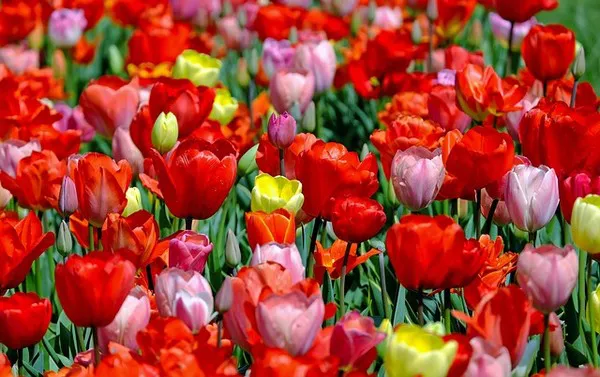Flowers, with their vibrant hues and delicate petals, have been cherished for centuries not only for their aesthetic appeal but also for the symbolic meanings they carry. The language of flowers, known as floriography, is a fascinating realm where emotions, sentiments, and messages are conveyed through the careful selection of blooms and their colors. In this exploration, we delve into the rich tapestry of meanings behind the colors of flowers, uncovering the nuanced language that has captivated cultures across time.
The Historical Roots of Floriography
Dating back to ancient civilizations, the use of flowers to convey messages has been documented in various cultures. The Victorians, in particular, elevated the language of flowers to an art form during the 19th century. Books like “The Language of Flowers” by Kate Greenaway provided a comprehensive guide to the meanings associated with different blooms, paving the way for the intricate floral arrangements that communicated sentiments ranging from love and friendship to grief and disdain.
Red: The Color of Passion and Love
Bold, passionate, and unmistakable, red flowers have long been synonymous with love and desire. The iconic red rose, perhaps the most renowned symbol of romantic love, has been featured in countless poems, artworks, and gestures of affection. Red tulips, carnations, and gerbera daisies also carry similar connotations, making them popular choices for declarations of love and admiration.
Beyond romantic love, red flowers can also signify courage, strength, and determination. In cultures where red is associated with good luck and prosperity, gifting red flowers may convey wishes for success and achievement.
Pink: Grace, Admiration, and Sweet Affection
Pink flowers exude a sense of grace, sweetness, and admiration. Lighter shades of pink, such as blush and pastel tones, often symbolize innocence and youthfulness. Pink roses, for instance, convey admiration and appreciation, making them an ideal choice for expressing gratitude or acknowledging someone’s accomplishments.
Deeper shades of pink may symbolize gratitude, while hot pink can represent playfulness and a sense of fun. Pink flowers, with their gentle and charming demeanor, are versatile messengers that convey a spectrum of emotions.
White: Purity, Innocence, and New Beginnings
White flowers are the epitome of purity and innocence. Representing a clean slate and new beginnings, they are often chosen for weddings and other significant life events. White lilies, for example, symbolize virtue and the restored innocence of the soul, making them a popular choice for funerals.
In some cultures, white flowers also symbolize peace and tranquility, offering a sense of calm and serenity. The simplicity and elegance of white blooms make them a timeless choice for a variety of occasions.
Yellow: Friendship, Joy, and Positivity
Bright and cheerful, yellow flowers evoke feelings of happiness, friendship, and positivity. Sunflowers, with their radiant golden petals, are a quintessential representation of joy and warmth. Yellow roses, daffodils, and tulips are also commonly associated with friendship and the sharing of positive vibes.
Yellow flowers can be powerful mood lifters, making them ideal gifts to celebrate achievements, express congratulations, or simply bring a ray of sunshine to someone’s day. The color’s association with energy and vitality adds a dynamic touch to the messages conveyed through yellow blooms.
Purple: Royalty, Luxury, and Enchantment
Symbolizing luxury, sophistication, and enchantment, purple flowers have a regal allure. The color purple has historically been associated with royalty and power, making it a fitting choice for conveying a sense of grandeur and admiration. Purple orchids, lavender, and lilacs are often chosen to express admiration and adoration.
On a more spiritual level, purple flowers can convey a sense of mystery and magic. The deep and rich tones of purple blooms add a touch of elegance to floral arrangements, making them a popular choice for upscale events and special occasions.
Blue and Green: Tranquility, Harmony, and Renewal
Less common in the floral spectrum, blue and green flowers are nonetheless captivating in their symbolism. Blue flowers often represent tranquility, serenity, and the calmness of the sea and sky. Delphiniums, hydrangeas, and forget-me-nots in shades of blue are chosen to convey a sense of peace and openness.
Green flowers, on the other hand, symbolize renewal, growth, and the enduring cycle of life. They are often associated with luck and good fortune, making them an auspicious choice for various celebrations. Green flowers, like chrysanthemums and bells of Ireland, bring a refreshing and harmonious element to floral arrangements.
Orange: Energy, Enthusiasm, and Vibrancy
Vibrant and energetic, orange flowers are a symbol of enthusiasm, warmth, and vitality. Marigolds, lilies, and zinnias in shades of orange convey a sense of energy and passion. The color is often associated with the changing seasons and the warmth of the sun, making it a popular choice for autumn-themed arrangements.
Orange flowers are also used to express a sense of pride and admiration. Whether as a gesture of encouragement or a celebration of achievements, the bold hues of orange blooms convey a positive and dynamic message.
Multicolored Bouquets: Expressing Complexity and Diversity
While each color carries its own distinct meaning, multicolored bouquets offer a canvas for expressing complex emotions and diverse sentiments. Combining different hues allows for a personalized and nuanced message, making such arrangements ideal for occasions that involve a range of emotions.
Multicolored bouquets are often chosen for celebrations, birthdays, or expressions of gratitude where a spectrum of feelings is involved. The thoughtful combination of colors in these arrangements allows for a more intricate and personalized expression of sentiments.
Conclusion
In the intricate world of flowers, colors transcend mere aesthetics, becoming a language of beauty and meaning. Each bloom, with its unique hue, carries a message that has the power to convey emotions, sentiments, and wishes in a way that words often fall short. As we continue to appreciate the timeless art of floriography, the colors of flowers remain a vibrant and cherished means of expression, connecting us to the rich tapestry of cultural history and human emotion.


